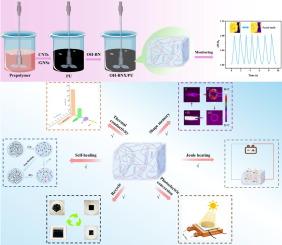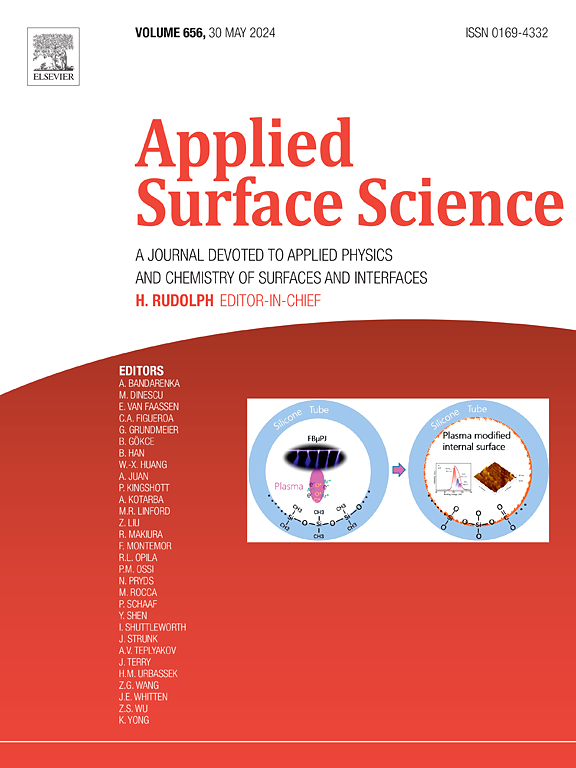IF 6.3
2区 材料科学
Q2 CHEMISTRY, PHYSICAL
引用次数: 0
摘要
相变材料(PCM)具有在恒定相变温度下吸收或释放大量潜热的特殊能力,因此被广泛用作热存储和温度调节介质。然而,与 PCM 相关的固有低导热性、固态刚性、亲水性和电绝缘等难题极大地限制了它们在柔性可穿戴热管理领域的实际应用。在这种情况下,本文介绍了一种简单而有效的方法来制造柔性复合 PCM 薄膜,这种薄膜具有更高的机械强度、疏水性、导电性和导热性。聚合物基体采用硼酸键、B-N 配位键和氢键相互作用作为牢固的物理交联。这种方法产生的复合材料具有惊人的机械强度(114.0 兆帕)、显著的自愈能力(80 ℃ 下 24 小时内自愈率达 81.08%)和可回收性(94%)。通过调节聚合物分子结构,复合材料实现了较高的疏水性(接触角为 134°)。此外,通过利用碳纳米管和石墨烯纳米片之间的相互作用,这些复合材料显示出 5.56 S/m 的导电性,有效地解决了 PEG 基材料固有的绝缘性能问题。值得注意的是,在加入改性六方氮化硼后,这些复合材料的散热性能大幅提高,导热效率高达 1033%。此外,这种复合 PCM 还表现出卓越的焦耳加热和光热转换效率(94.31%,输入功率密度为 100 mW-cm-2)以及出色的储能能力。同时,这种复合 PCM 能够快速监测人体运动活动和肌肉的细微变化(标准因子 GF = 7.99)。因此,将太阳能收集与焦耳加热集成到可穿戴柔性 PCM 中,为开发下一代个人热管理系统提供了广阔的前景,该系统可适应各种天气条件和季节,同时具有双模式触发功能,适用于复杂多变的应用。本文章由计算机程序翻译,如有差异,请以英文原文为准。

Flexible phase change sensors with improved heat dissipation for wearable thermal management
Phase change materials (PCMs) are extensively utilized as mediums for thermal storage and temperature regulation, owing to their exceptional capacity to absorb or release substantial amounts of latent heat at a constant phase change temperature. However, the intrinsic low thermal conductivity, solid-state rigidity, hydrophilicity, and electrical insulation challenges associated with PCMs significantly restrict their practical applications in the domain of flexible wearable thermal management. In this context, this paper introduces a straightforward yet effective method for fabricating flexible composite PCM films that exhibit enhanced mechanical strength, hydrophobicity, electrical conductivity, and improved thermal conductivity. The polymer matrix employs boronic acid bonding, B-N coordination bonding, and hydrogen bonding interactions as robust physical cross-links. This approach yields composites with impressive mechanical strength (114.0 MPa), notable self-healing capabilities (81.08 % self-healing within 24 h at 80 ℃), and recyclability (94 %). The composites achieved high hydrophobicity (contact angle of 134°) through modulation of the polymer molecular structure. Furthermore, by leveraging the interaction between carbon nanotubes and graphene nanosheets, these composites exhibited an electrical conductivity of 5.56 S/m-effectively addressing the insulating properties inherent to PEG-based materials. Remarkably, the heat dissipation performance of these composites was substantially enhanced-with a thermal conductive efficiency reaching up to 1033 %-following the incorporation of modified hexagonal boron nitride. Additionally, the composite PCM demonstrated excellent Joule heating and photothermal conversion efficiencies (94.31 %, under an input power density of 100 mW·cm−2) alongside superior energy storage capabilities. Simultaneously, this composite PCM is capable of rapidly monitoring human motor activities and subtle muscle changes (with a normative factor GF = 7.99). Therefore, integrating solar energy harvesting with Joule heating into a wearable flexible PCM presents promising potential for developing next-generation personal thermal management systems that are adaptable across various weather conditions and seasons while being dual-mode triggered for complex variable applications.
求助全文
通过发布文献求助,成功后即可免费获取论文全文。
去求助
来源期刊

Applied Surface Science
工程技术-材料科学:膜
CiteScore
12.50
自引率
7.50%
发文量
3393
审稿时长
67 days
期刊介绍:
Applied Surface Science covers topics contributing to a better understanding of surfaces, interfaces, nanostructures and their applications. The journal is concerned with scientific research on the atomic and molecular level of material properties determined with specific surface analytical techniques and/or computational methods, as well as the processing of such structures.
 求助内容:
求助内容: 应助结果提醒方式:
应助结果提醒方式:


